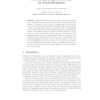Free Online Productivity Tools
i2Speak
i2Symbol
i2OCR
iTex2Img
iWeb2Print
iWeb2Shot
i2Type
iPdf2Split
iPdf2Merge
i2Bopomofo
i2Arabic
i2Style
i2Image
i2PDF
iLatex2Rtf
Sci2ools
ECCV
2008
Springer
2008
Springer
Constructing Category Hierarchies for Visual Recognition
Abstract. Class hierarchies are commonly used to reduce the complexity of the classification problem. This is crucial when dealing with a large number of categories. In this work, we evaluate class hierarchies currently constructed for visual recognition. We show that top-down as well as bottom-up approaches, which are commonly used to automatically construct hierarchies, incorporate assumptions about the separability of classes. Those assumptions do not hold for visual recognition of a large number of object categories. We therefore propose a modification which is appropriate for most top-down approaches. It allows to construct class hierarchies that postpone decisions in the presence of uncertainty and thus provide higher recognition accuracy. We also compare our method to a one-against-all approach and show how to control the speed-foraccuracy trade-off with our method. For the experimental evaluation, we use the Caltech-256 visual object classes dataset and compare to stateof-the-a...
Class Hierarchies | Computer Vision | ECCV 2008 | Large Number | Top-down Approaches | Visual Object Classes | Visual Recognition |
| Added | 15 Oct 2009 |
| Updated | 15 Oct 2009 |
| Type | Conference |
| Year | 2008 |
| Where | ECCV |
| Authors | Marcin Marszalek, Cordelia Schmid |
Comments (0)

